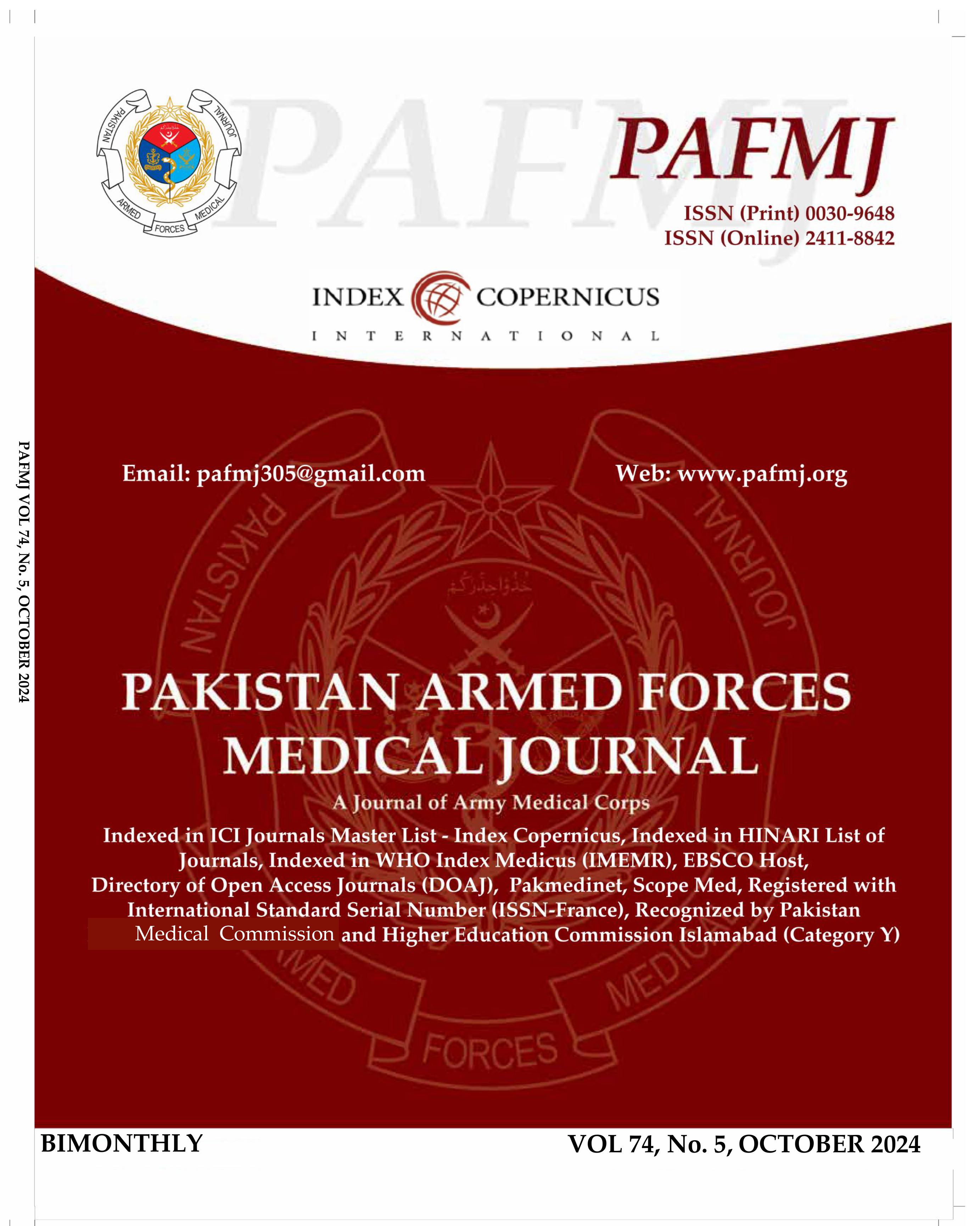Barriers to Bedside Teaching: A Cross-Sectional Comparative Survey of Students and Faculty
DOI:
https://doi.org/10.51253/pafmj.v74i5.5061Keywords:
Bedside teaching, Clinical faculty, Students.Abstract
Objective: To identify the barriers to bedside teaching among students and clinical faculty.
Study Design: Cross sectional comparative study.
Place and Duration of Study: Pak Emirates Military Hospital, Rawalpindi Pakistan, from Dec 2019 to Jun 2020.
Methodology: The study participants included undergraduate students, postgraduate students and clinical faculty members. A self-designed questionnaire listing 25 common barriers to bedside teaching was distributed after pilot testing.
Results: The total number of participants was 160, out of which 78(48.75%) were males, and 82(51.25%) were females. There were 40 respondents in each of the categories of consultants, postgraduate trainees and 80 in the undergraduate student category. Twenty consultants (50%) were from Medicine and Allied specialties, 10(25%) from Surgical and Allied specialties while 10(25%) did not mention their specialty. Majority of postgraduate trainees 33(82.5%) were from Medicine and Allied specialties. Significant difference (p-value=0.004) was revealed among students and faculty regarding barriers to bedside teaching. Bedside teaching was accorded more value by faculty (p-value=0.026). Faculty deemed ambiguity in curriculum as a more important barrier as compared to the students (p-value=0.037). Common barriers identified by students were inadequate time allocation (p-value<0.001), large student groups (p-value<0.001), performance pressure on faculty (p-value=0.004), lack of problem solving skill teaching (p-value=0.028) and insufficient feedback (p-value=0.044).
Conclusion: Students as well as faculty value the role of bedside teaching in medical education but are cognizant of significant barriers in its execution. There are a number of common impediments that are narrated by both groups but students accord more importance to larger gro
Downloads
References
Peters M, ten Cate O. Bedside teaching in medical education: a literature review. Perspect Med Educ 2014; 3(2): 76-88.
Doherty EG, Brodsky D. Bedside teaching: rediscovering a lost art. Neo Rev 2012; 13(5): e271.
Mosalanejad L, Hojjat M, Gholami M. A holistic approach to bedside teaching from the views of main users. Middle East J Nurs 2014; 8: 24‑29.
Garout M, Nuqali A, Alhazmi A, Almoallim H. Bedside teaching: an underutilized tool in medical education. Int J Med Educ 2016; 7: 261-262.
Crumlish CM, Yialamas MA, McMahon GT. Quantification of bedside teaching by an academic hospitalist group. J Hosp Med 2009; 4(5): 304-307.
Rousseau M, Könings KD, Touchie C. Overcoming the barriers of teaching physical examination at the bedside: more than just curriculum design. BMC Med Educ 2018; 18(1): 302.
Williams KN, Ramani S, Fraser B, Orlander JD. Improving bedside teaching: findings from a focus group study of learners. Acad Med 2008; 83(3): 257-264.
Asani M. Bedside teaching: An indispensable model of patient-centred teaching in undergraduate medical education. Nigerian J Basic Clinical Sci 2014; 11(2): 57.
Ramani S, Orlander JD, Strunin L, Barber TW. Whither Bedside Teaching? A Focus‐group Study of Clinical Teachers. Acad Med 2003; 78(4): 384-390.
Khan IA. Bedside Teaching-Making It An Effective Instructional Tool. J Ayub Med Coll Abbottabad 2014; 26(3): 286-289.
Narayanan V, Nair BR. The value of bedside teaching in undergraduate medical education: a literature review. Med Ed Publish 2020 ; 9.
Holla R, Shrisha M, Unnikrishnan B, Sharma N, Janani S, Thapar R et al. Facilitators And Barriers For Bedside Teaching In The Teaching Hospitals Of Coastal South India. Asian J Pharm Clin Res 2015. 8(2): 271-273.
Rockey NG, Ramos GP, Romanski S, Bierle D, Bartlett M, Halland M. Patient participation in medical student teaching: a survey of hospital patients. BMC Med Educ 2020; 20: 1-9.
Shehab A. Clinical teachers’ opinions about bedside-based clinical teaching. Sultan Qaboos Univ Med J 2013; 13(1): 121.
Olasoji HO, Mu’azu AB, Garba MH. A study of clinical teachers’ attitude to teaching and perceived learning needs in a medical college in Nigeria. Adv Health Sci Educ Theory Prac 2019; 10: 605-617.
Babayev R, Tortez L, Kozikowski A, Wolf-Klein G, Loehner J, Dlugacz Y, et al. Attending physicians’ attitudes towards physical exam and bedside teaching. Med Ed 2016; 5.
Mangione S. Cardiac auscultatory skills of physicians-in-training: a comparison of three English-speaking countries. Am J Med 2001; 110(3): 210-216.
Tariq M, Motiwala A, Ali SU, Riaz M, Awan S, Akhter J. The learners' perspective on internal medicine ward rounds: a cross-sectional study. BMC Med Educ 2010; 10(1): 53.
Alpert JS. Some thoughts on bedside teaching. Am J Med 2009 Mar 1; 122(3): 203-204.
Schüttpelz-Brauns K, Narciss E, Schneyinck C, Böhme K, Brüstle P, Mau-Holzmann U, et al. Twelve tips for successfully implementing logbooks in clinical training. Med Teach 2016; 38 (6): 564-569.
Nandini C, Suvajit D, Kaushik M, Chandan C. Students’ and teachers’ perceptions of factors leading to poor clinical skill development in medical education: a descriptive study. Edu Res Int 2015; 78: 8-53.
Al-Swailmi FK, Khan IA, Mehmood Y, Al-Enazi SA, Alrowaili M, Al-Enazi MM. Students’ perspective of bedside teaching: A qualitative study. Pak J Med Sci 2016; 32(2): 351.
Beigzadeh A, Bahaadinbeigy K, Adibi P, Yamani I. Identifying the challenges to good clinical rounds: A focus-group study of medical teachers. J Adv Med Educ Prof 2019; 7(2): 62.
Young L, Orlandi A, Galichet B, Heussler H. Effective teaching and learning on the wards: easier said than done? Med Educ 2009; 43(8): 808-817.
Gray D, Cozar O, Lefroy J. Medical students' perceptions of bedside teaching. Clin Teach 2017; 14(3): 205-210.
Downloads
Published
Issue
Section
License
Copyright (c) 2024 Shazia Nisar, SH Waqar

This work is licensed under a Creative Commons Attribution-NonCommercial 4.0 International License.















